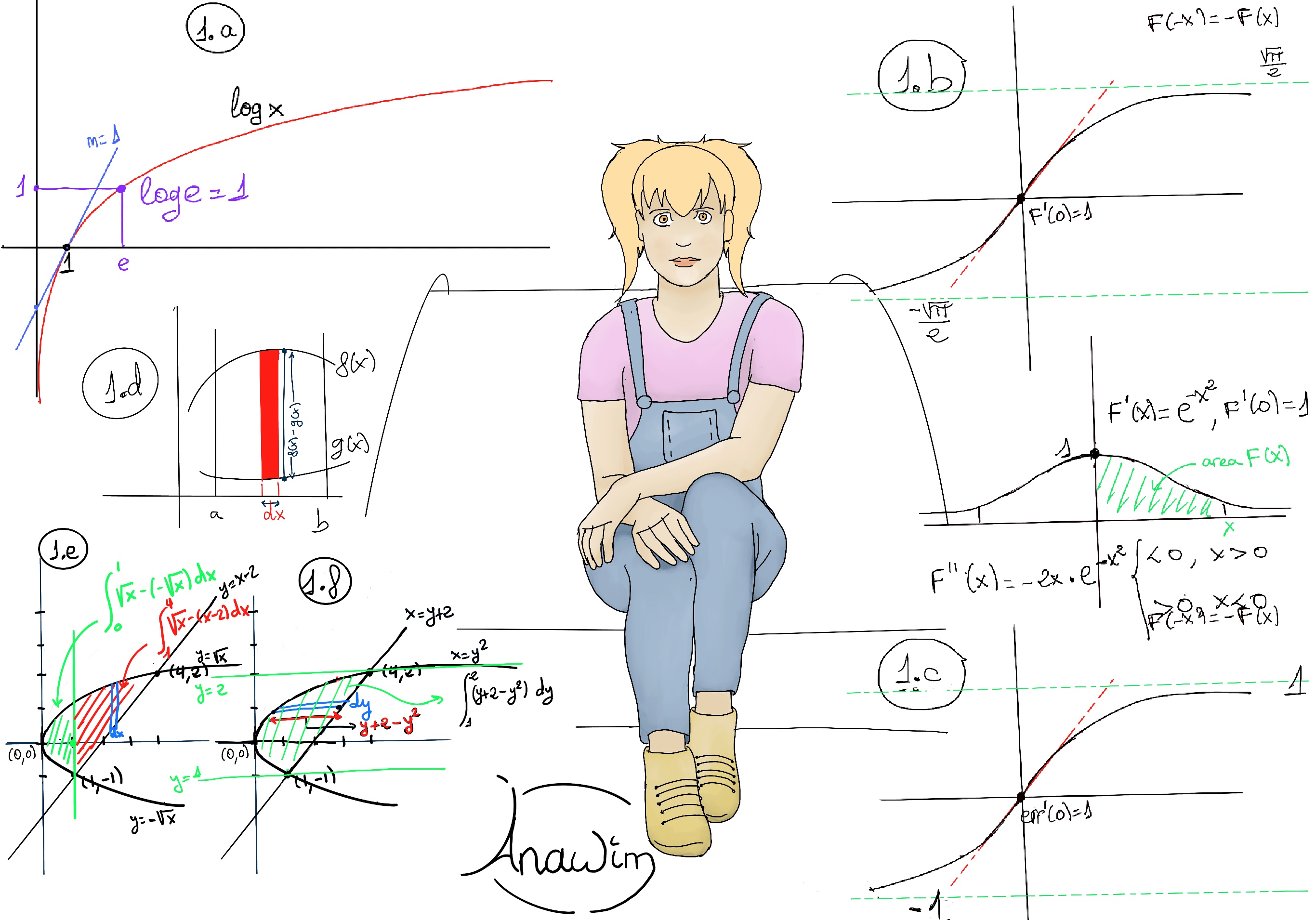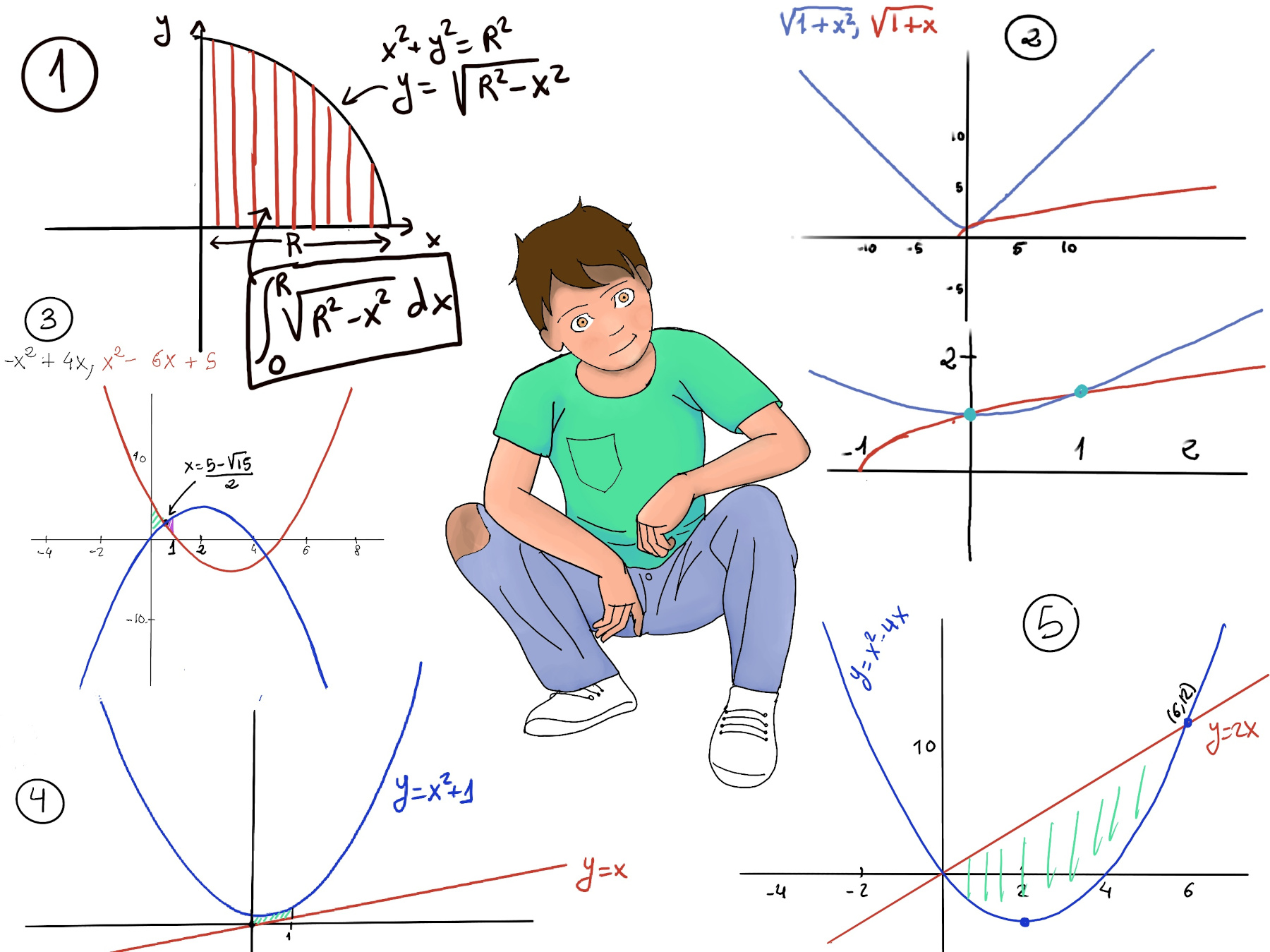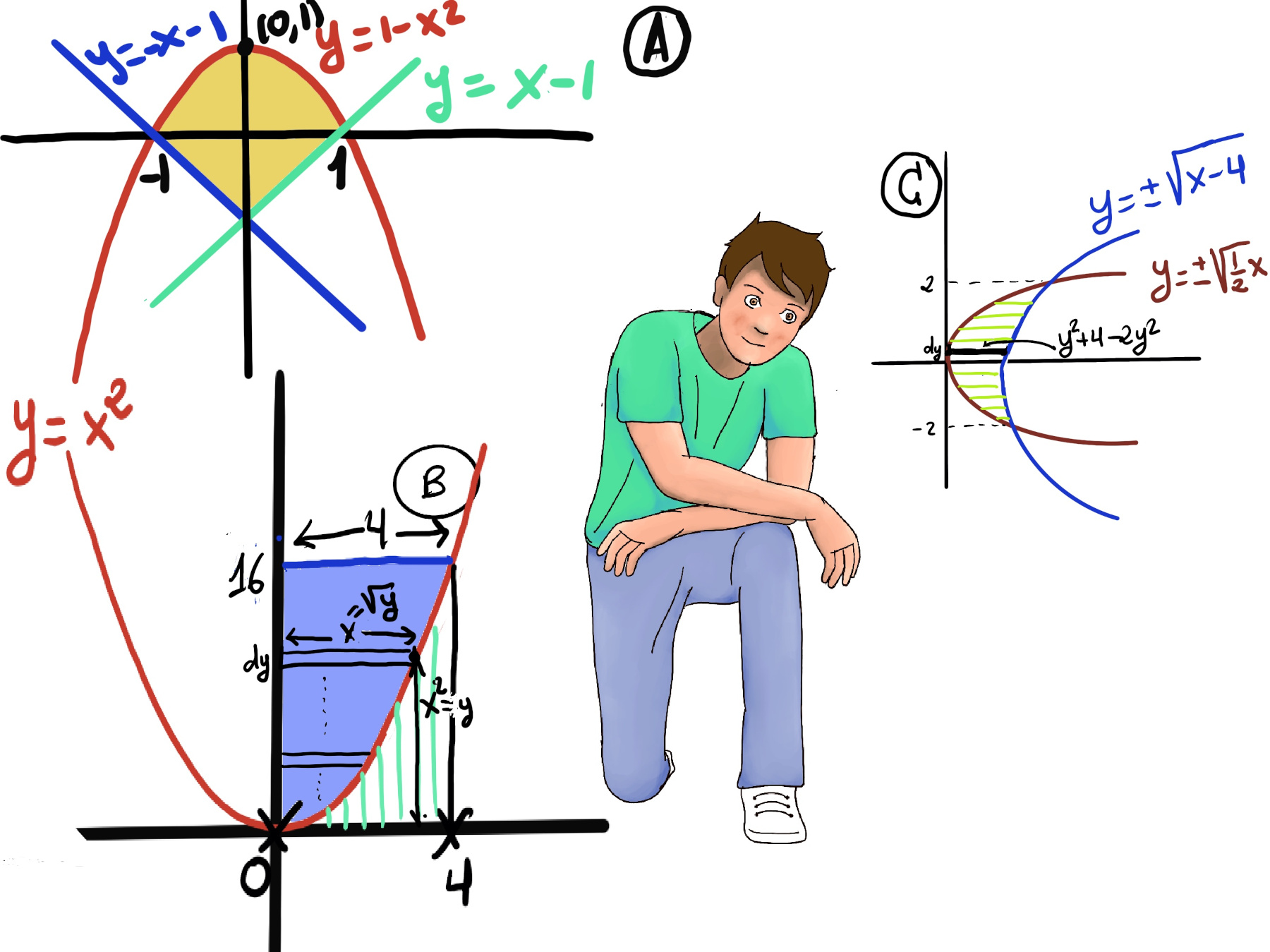
|
 |
 |

|
 |
 |
He may look like an idiot and talk like an idiot but don’t let that fool you. He really is an idiot, Groucho Marx.
Antiderivatives are fundamental concepts in calculus. They are the inverse operation of derivatives.
Given a function f(x), an antiderivative, also known as indefinite integral, F, is the function that can be differentiated to obtain the original function, that is, F’ = f, e.g., 3x2 -1 is the antiderivative of x3 -x +7 because $\frac{d}{dx} (x^3-x+7) = 3x^2 -1$. Symbolically, we write F(x) = $\int f(x)dx$.
The process of finding antiderivatives is called integration.
The Fundamental Theorem of Calculus states roughly that the integral of a function f over an interval is equal to the change of any antiderivate F (F'(x) = f(x)) between the ends of the interval, i.e., $\int_{a}^{b} f(x)dx = F(b)-F(a)=F(x) \bigg|_{a}^{b}$
We want to determine the area between y = f(x) and y = g(x) on the interval [a, b]. For simplicity sake, we are also going to assume that f(x) ≥ g(x).
We could draw “small” rectangles whose areas are dx·(f(x)-g(x)) (Area = base·height). The total area on the interval [a, b] is the definite integral $\int_{a}^{b} (f(x)-g(x))dx$ -Figure 1.d.-.
In general, the area between two curves representing two arbitrary functions, say f and g, can be found by taking the definite integral of the absolute difference between the two functions over the interval of interest.


First, we need to calculate the points of intersection of the two curves. $2x = x^2 -4x ⇒ x^2 -6x = 0 ⇒ x(x-6)=0 ⇒ x = 0, 6$. These are the points of intersection.
For x ∈ [0, 6], the upper function is y = 2x, and the lower function is y = x2 - 4x.
The integral to find the area is $\int_{0}^{6} 2x-(x^2-4x)dx = \int_{0}^{6} (-x^2+6x)dx = \frac{-x^3}{3}+\frac{6x^2}{2} = \frac{-x^3}{3}+3x^2\bigg|_{0}^{6} = \frac{(-6)^3}{3}+3·6^2 = 36$.

The easiest method is by subtraction. Area = $4*16-\int_{0}^{4} x^2dx = 64 -\frac{x^3}{3}\bigg|_{0}^{4} = 64 -\frac{4^3}{3} = \frac{128}{3}units^2$
We can also use horizontal slices with “small” heights dy and widths $\sqrt{y}$ from (0, 0) to (16, 4). Area = $\int_{0}^{16} \sqrt{y}dy = \frac{y^{\frac{3}{2}}}{\frac{3}{2}} = \frac{2}{3}y^{\frac{3}{2}}\bigg|_{0}^{16} = \frac{2}{3}16^{\frac{3}{2}} = \frac{2}{3}(16^{\frac{1}{2}})^3 = \frac{2}{3}(4^3) = \frac{64·2}{3} = \frac{128}{3}~units^2.$

$y = ± \sqrt{\frac{1}{2}x} ↭ y^2 = \frac{1}{2}x ↭ x = 2y^2.~ y = ± \sqrt{x -4} ↭y^2 = x -4 ↭ x = y^2+4$
We are going to integrate with respect to y or, in other words, we will use horizontal slices with “small” heights dy and widths $y^2+4-2y^2$ from -2 to 2.
Area = $\int_{-2}^{2} (y^2+4-2y^2)dy = \int_{-2}^{2} (-y^2+4)dy = \frac{-y^3}{3}+4y\bigg|_{-2}^{2} = \frac{-8}{3}+8-(\frac{8}{3}-8) = \frac{-16}{3}+16 = \frac{-16}{3}+\frac{48}{3} = \frac{32}{3}~units^2.$
Calculate the points of intersection, in our particular case where x = y2 and y = x -2 intersect. y = x -2 ⇒ x = y +2 =[x = y2] y2 ↭ y + 2 = y2 ↭ y2 -y -2 = 0, (y -2)(y +1) = 0, y = 2 (4, 2) or y = -1 (1, -1).
Area =[Figure 1.e. Using vertical slices] $\int_{0}^{1} (\sqrt{x}-(-\sqrt{x}))dx$ (Left section, green area) + $\int_{1}^{4} (\sqrt{x}-(x-2))dx$ (Right section, red area) = $\int_{0}^{1} 2\sqrt{x}dx + \int_{1}^{4} (\sqrt{x}-(x-2)) = \int_{0}^{1} 2\sqrt{x}dx + \int_{1}^{4} (\sqrt{x}-x+2) = \left[ \frac{4}{3}x^{\frac{3}{2}} \right]_{0}^{1} +$
$\left[ \frac{2}{3}x^{\frac{3}{2}} - \frac{1}{2}x^2 + 2x \right]_{1}^{4} = \frac{4}{3}(1)^{\frac{3}{2}} - \frac{2}{3}(0)^{\frac{3}{2}} + \frac{2}{3}(4)^{\frac{3}{2}} - \frac{1}{2}(4)^2 + 2(4) - \frac{2}{3}(1)^{\frac{3}{2}} + \frac{1}{2}(1)^2 - 2(1)= \frac{4}{3}+\frac{2}{3}8 + -8 + 8 -\frac{2}{3}+\frac{1}{2}-2 = \frac{2}{3} +\frac{2}{3}8 + +\frac{1}{2}-2 = \frac{4+32+3-12}{6} = \frac{27}{6} = \frac{9}{2}$
Area =[Using horizontal slices with “small” heights dy and widths (y+2) -y2 from (1, -1) to (4, 2), Figure 1.f] $\int_{-1}^{2} (y+2-y^2)dy = (\frac{y^2}{2}+2y-\frac{y^3}{3})\bigg|_{2}^{-1} = \frac{1}{2}(2)^2 + 2(2) - \frac{1}{3}(2)^3 -(\frac{1}{2}(-1)^2 + 2(-1) - \frac{1}{3}(-1)^3)= \frac{10}{3}+\frac{7}{6} = \frac{20}{6}+\frac{7}{6} = \frac{27}{6} = \frac{9}{2}.$


Calculate the points of intersection of the two curves $-x^2+4x = x^2-6x+5 ↭ 2x^2-10x +5 = 0↭ x = \frac{10±\sqrt{100-40}}{4}= \frac{5±\sqrt{15}}{2}, x = \frac{5-\sqrt{15}}{2} ∈ [0, 1]$. For the sake of brevity, i = $\frac{5-\sqrt{15}}{2}$.
Determine the intervals of interest: $[0, \frac{5-\sqrt{15}}{2}], [\frac{5-\sqrt{15}}{2}, 1]$
Take the absolute difference between the two functions and integrate over each interval separately to find the area.
$\int_{0}^{i} x^2-6x+5 -(-x^2+4x)dx + \int_{i}^{1} -x^2+4x - (x^2-6x+5)dx = \int_{0}^{i} (2x^2-10x+5)dx + \int_{i}^{1} (-2x^2+10x-5)dx = \frac{2x^3}{3}-\frac{10x^2}{2}+5x\bigg|_{0}^{i}$ +
$-\frac{2x^3}{3}+\frac{10x^2}{2}-5x\bigg|_{i}^{1} = $… = $\frac{-52}{3}+5\sqrt{15}$
To calculate the area of the shaded region bounded by the curves y = -x-1, y = 1 -x2, y = x -1, we need to find the points of intersection. For y = -x-1, y = 1 -x2, -x -1 = 1 -x2 ↭ x2-x -2 = 0 ↭ (x-2)(x+1) = 0 ↭ x = 2, -1. For y = 1 -x2 and y = x -1, 1 -x2 = x -1 ↭ x2 + x -2 = 0 ↭ (x+2)(x-1) = 0 ↭ x = -2, x = 1.
The shaded region is composed of two segments: The segment between y = 1 - x2 and y = x −1 from x = -1 to x = 0. The segment between 1 - x2 and y = x - 1 from x = 0 to x = 1.
$\int_{-1}^{0} ((1-x^2)-(-x-1))dx + \int_{0}^{1} ((1-x^2)-(x-1))dx =$[Because the graph is symmetric respect to the y-axix] $2\int_{0}^{1} (-x^2-x+2)dx = 2(\frac{-x^3}{3}-\frac{x^2}{2}+2x)\bigg|_{0}^{1} = 2(\frac{-1}{3} -\frac{1}{2}+2)= 2(\frac{-2}{6}-\frac{3}{6}+\frac{12}{6}) = 2·\frac{7}{6} = \frac{7}{3}.$
